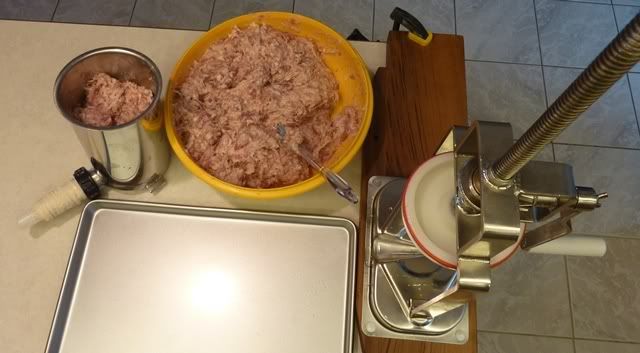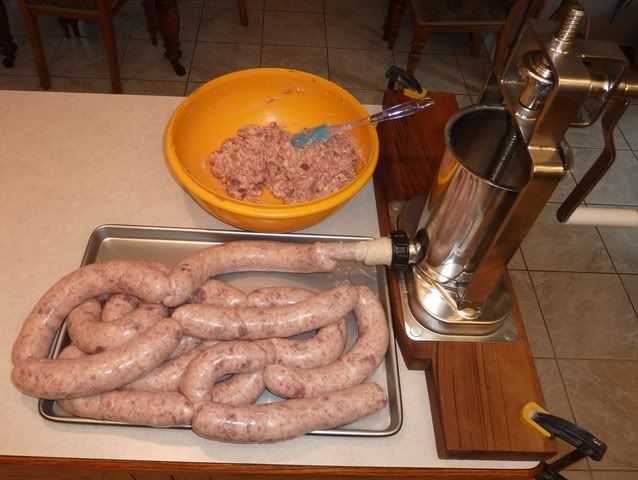Bruce McLeod
TVWBB Member
Managed to get a twin pack of pork butts on sale last week... One became pulled pork and the other, kielbasa.
In Poland, almost all sausage is called 'kielbasa'. Krakowska Krajana sausage, always one of the top 5 sellers in Poland, derives its name from the old previous Polish capital city of Kraków (Crakow). The middle part of the name “krajana” implies that the meat is manually cut into pieces. This has become my 'go-to' kielbasa recipe because it turns out well almost every time I make it.
Here's the process I used:
1. Basically, after the butt is boned and trimmed, the back fat (about 5% of total weight) is removed and diced, then set aside.
2. The other internal 'soft fat' is removed, cut into ~2" pieces and set aside.
3. Although many Polish recipes for this sausage call for the leanest meat to be cut into 2" pieces, here I trimmed, then diced the leanest meat into 3/4" pieces and set it aside
4. Finally, I trimmed the remaining 'fatty' meat, diced it into 1" chunks and set it aside.
5. Weighed all the separated meat/fat with the goal of having fat content as 25% of total weight.
6. Ran the back fat through a 3/16" disc on the grinder then the rest of the 'fatty meat' through the same disc. (The soft fat isn't ground).
7. Measured and mixed the spices and cure (for 11 lbs of meat/fat), then weighed and proportioned the mix according to the weight of each type of meat/fat to which it will be added.
8. Added the spices and cure to each 'set aside' meat/fat batch, thoroughly mixed each batch, then refrigerated everything overnight.
9. Next day added some of the ground 'fatty meat' to the soft fat until it was about 15% of the total weight (I'm guessing that the rest of the fat in the ground meat will be about 5% while the back fat is 5%).
10. Chilled this until almost frozen, then processed it in the food processor with ~2 cups ice-cold water until it was pretty much 'emulsified' and 'gluey' - which shouldn't take more than 90 seconds or so.
11. Combine everything (cubed lean meat, ground fatty meat, ground back fat and emulsified fat) and thoroughly mix it together by hand.
12. Soak casings in water for at least one hour before loading them on the stuffer horn (tube).
13. Pack sausage mixture into the stuffer and stuff into size 43-45 hog casings.

Note: I use the $80 Grizzly 5lb model - mounted on a 1.5" thick red cedar base and secured to the counter with quick-grip clamps.

14. Refrigerate kielbasa overnight.
15. The following day, I smoked them with applewood on the WSM, beginning with mini-minion, to internal 154˚.
16. Plunge kielbasa into ice-water, then refrigerate until ready to use.

These are great cold or lightly heated in a pan.
Enjoy!!
In Poland, almost all sausage is called 'kielbasa'. Krakowska Krajana sausage, always one of the top 5 sellers in Poland, derives its name from the old previous Polish capital city of Kraków (Crakow). The middle part of the name “krajana” implies that the meat is manually cut into pieces. This has become my 'go-to' kielbasa recipe because it turns out well almost every time I make it.
Here's the process I used:
1. Basically, after the butt is boned and trimmed, the back fat (about 5% of total weight) is removed and diced, then set aside.
2. The other internal 'soft fat' is removed, cut into ~2" pieces and set aside.
3. Although many Polish recipes for this sausage call for the leanest meat to be cut into 2" pieces, here I trimmed, then diced the leanest meat into 3/4" pieces and set it aside
4. Finally, I trimmed the remaining 'fatty' meat, diced it into 1" chunks and set it aside.
5. Weighed all the separated meat/fat with the goal of having fat content as 25% of total weight.
6. Ran the back fat through a 3/16" disc on the grinder then the rest of the 'fatty meat' through the same disc. (The soft fat isn't ground).
7. Measured and mixed the spices and cure (for 11 lbs of meat/fat), then weighed and proportioned the mix according to the weight of each type of meat/fat to which it will be added.
8. Added the spices and cure to each 'set aside' meat/fat batch, thoroughly mixed each batch, then refrigerated everything overnight.
9. Next day added some of the ground 'fatty meat' to the soft fat until it was about 15% of the total weight (I'm guessing that the rest of the fat in the ground meat will be about 5% while the back fat is 5%).
10. Chilled this until almost frozen, then processed it in the food processor with ~2 cups ice-cold water until it was pretty much 'emulsified' and 'gluey' - which shouldn't take more than 90 seconds or so.
11. Combine everything (cubed lean meat, ground fatty meat, ground back fat and emulsified fat) and thoroughly mix it together by hand.
12. Soak casings in water for at least one hour before loading them on the stuffer horn (tube).
13. Pack sausage mixture into the stuffer and stuff into size 43-45 hog casings.

Note: I use the $80 Grizzly 5lb model - mounted on a 1.5" thick red cedar base and secured to the counter with quick-grip clamps.

14. Refrigerate kielbasa overnight.
15. The following day, I smoked them with applewood on the WSM, beginning with mini-minion, to internal 154˚.

16. Plunge kielbasa into ice-water, then refrigerate until ready to use.

These are great cold or lightly heated in a pan.
Enjoy!!
Last edited:
